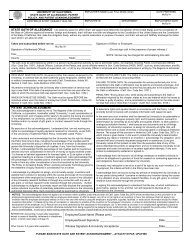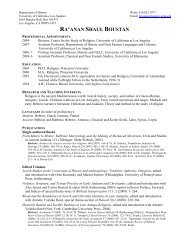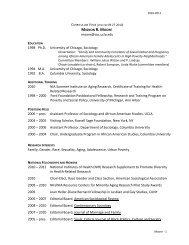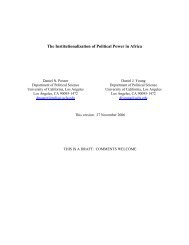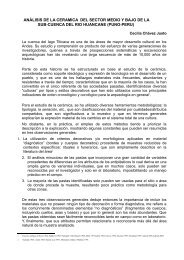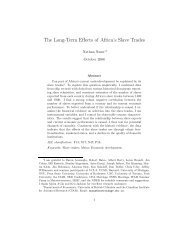EOP Historical Tables of the U.S. Budget - Social Sciences Division
EOP Historical Tables of the U.S. Budget - Social Sciences Division
EOP Historical Tables of the U.S. Budget - Social Sciences Division
You also want an ePaper? Increase the reach of your titles
YUMPU automatically turns print PDFs into web optimized ePapers that Google loves.
HISTORICAL TRENDS<br />
Because <strong>the</strong> <strong>Historical</strong> <strong>Tables</strong> publication<br />
provides a large volume and wide array<br />
<strong>of</strong> data on Federal Government finances,<br />
it is sometimes difficult to perceive <strong>the</strong> longer<br />
term patterns in various budget aggregates<br />
and components. To assist <strong>the</strong> reader in<br />
understanding some <strong>of</strong> <strong>the</strong>se longer term<br />
patterns, this section provides a short summary<br />
<strong>of</strong> <strong>the</strong> trends in Federal deficits and<br />
surpluses, debt, receipts, outlays and employment.<br />
Deficits and Debt.—As shown in Table<br />
1.1, except for periods <strong>of</strong> war (when spending<br />
for defense increased sharply), depressions<br />
or o<strong>the</strong>r economic downturns (when receipts<br />
fell precipitously), <strong>the</strong> Federal budget was<br />
generally in surplus throughout most <strong>of</strong> <strong>the</strong><br />
Nation’s first 200 years. For our first 60<br />
years as a Nation (through 1849), cumulative<br />
budget surpluses and deficits yielded a net<br />
surplus <strong>of</strong> $70 million. The Civil War, along<br />
with <strong>the</strong> Spanish-American War and <strong>the</strong><br />
depression <strong>of</strong> <strong>the</strong> 1890s, resulted in a cumulative<br />
deficit totaling just under $1 billion<br />
during <strong>the</strong> 1850–1900 period. Between 1901<br />
and 1916, <strong>the</strong> budget hovered very close<br />
to balance every year. World War I brought<br />
large deficits that totaled $23 billion over<br />
<strong>the</strong> 1917–1919 period. The budget was <strong>the</strong>n<br />
in surplus throughout <strong>the</strong> 1920s. However,<br />
<strong>the</strong> combination <strong>of</strong> <strong>the</strong> Great Depression<br />
followed by World War II resulted in a<br />
long, unbroken string <strong>of</strong> deficits that were<br />
historically unprecedented in magnitude. As<br />
a result, Federal debt held by <strong>the</strong> public<br />
mushroomed from less than $3 billion in<br />
1917 to $16 billion in 1930 and <strong>the</strong>n to<br />
$242 billion by 1946. In relation to <strong>the</strong><br />
size <strong>of</strong> <strong>the</strong> economy, debt held by <strong>the</strong> public<br />
grew from 16% <strong>of</strong> GDP in 1930 to 111%<br />
in 1946.<br />
During much <strong>of</strong> <strong>the</strong> postwar period, this<br />
same pattern persisted—large deficits were<br />
incurred only in time <strong>of</strong> war (e.g., Korea<br />
and Vietnam) or as a result <strong>of</strong> recessions.<br />
As shown in Table 1.2, prior to <strong>the</strong> 1980s,<br />
postwar deficits as a percent <strong>of</strong> GDP reached<br />
<strong>the</strong>ir highest during <strong>the</strong> 1975–76 recession<br />
at 4.3% in 1976. Debt held by <strong>the</strong> public<br />
had grown to $477 billion by 1976, but,<br />
because <strong>the</strong> economy had grown faster, debt<br />
as a percent <strong>of</strong> GDP had declined throughout<br />
<strong>the</strong> postwar period to a low <strong>of</strong> 23.9% in<br />
1974, climbing back to 27.6% in 1976. Following<br />
five years <strong>of</strong> deficits averaging 2.5%<br />
<strong>of</strong> GDP between 1977-1981, debt held by<br />
<strong>the</strong> public rose to 25.8% <strong>of</strong> GDP by 1981,<br />
only two percentage points higher than its<br />
postwar low.<br />
The traditional pattern <strong>of</strong> running large<br />
deficits only in times <strong>of</strong> war or economic<br />
downturns was broken during <strong>the</strong> rest <strong>of</strong><br />
<strong>the</strong> 1980s. In 1982, large tax cuts were<br />
enacted as were substantial increases in<br />
defense spending. Reductions in nondefense<br />
spending were not sufficient to <strong>of</strong>fset <strong>the</strong><br />
impact on <strong>the</strong> deficit. As a result, deficits<br />
averaging $207 billion were incurred between<br />
1983 and 1992. As a result <strong>of</strong> <strong>the</strong>se unprecedented<br />
peacetime deficits, debt held by <strong>the</strong><br />
public grew from $785 billion in 1981 to<br />
$3.0 trillion in 1992.<br />
Since peaking at $290 billion in 1992,<br />
deficits have declined each year, dropping<br />
to a level <strong>of</strong> $107 billion in 1996. As a<br />
percent <strong>of</strong> GDP, deficits were reduced by<br />
more than two-thirds during those 4 years,<br />
from 4.7% in 1992 to 1.4% in 1996.<br />
Receipts.— From <strong>the</strong> beginning <strong>of</strong> <strong>the</strong> Republic<br />
until <strong>the</strong> start <strong>of</strong> <strong>the</strong> Civil War,<br />
our Nation relied on customs duties to finance<br />
<strong>the</strong> activities <strong>of</strong> <strong>the</strong> Federal Government.<br />
During <strong>the</strong> 19th Century, sales <strong>of</strong> public<br />
lands supplemented customs duties. While<br />
large amounts were occasionally obtained from<br />
<strong>the</strong> sale <strong>of</strong> lands, customs duties accounted<br />
for over 90% <strong>of</strong> Federal receipts in most<br />
years prior to <strong>the</strong> Civil War. Excise taxes<br />
became an important and growing source<br />
<strong>of</strong> Federal receipts starting in <strong>the</strong> 1860s.<br />
Estate and gift taxes were levied and collected<br />
sporadically from <strong>the</strong> 1860s through World<br />
War I, although never amounting to a significant<br />
source <strong>of</strong> receipts during that time.<br />
Prior to 1913, income taxes did not exist<br />
or were inconsequential, o<strong>the</strong>r than for a<br />
15



